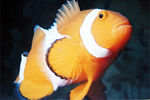|
Photos: Although one never bores of playing with them during dives, clownfish are frustrating to photograph, since they are quite shy and come out only when one moves away. I have lost a lot of time and photos, between patience and annoyment, for some decent shots. The only exception in Indonesia was a female spinecheek, whom I slightly brought towards my camera with my glove to capture her annorment as shw bit the frame. Her colours are intense because of the agitation I provoked in her. In Malaysia and ThailandI was much more fortunate with clownfish pictures, and am happy I even tried when I thought it was hopeless. Description: A symbol of marine life for many, they are one of the most amusing, beautiful and interesting species. They are also often used as an example of symbiosis, since they are protected by a mucus from the small venimous hooks of the anemone in which it seeks refuge, and which it cleans of debris. It is not the only host of these fascinating anemones, but most often the most visible, because of its bright colours which gave it its name. There are many types of anemone fish although they initially look alike. An interesting characteristic is that the female is often twice as big as the male and sometimes has different colours. Most species are linked to a particular anemone, and hide when one gets within 50cm, apart from some females who defend their territory by attacking - a suprising and intriguing event for a diver. Type | Max size | Habitat - Depth - Rareness - N/D- Comments | N | Spinecheek | Ć 6cmü12cm | One anemone, 3-25m, fairly frequent, diurnal, the femal attacks and the male hides | J | Skunk | 10cm | One anemone, 3-25m, fairly frequent, diurnal, hide | J | Pink | 10cm | One anemone, 3-25m, fairly frequent, many indiviudals who come out when one moves away | J | Clark's | 12cm | Several anemones, 3-25m, frequent, a couple and some individuals who hide | J |
|
|



